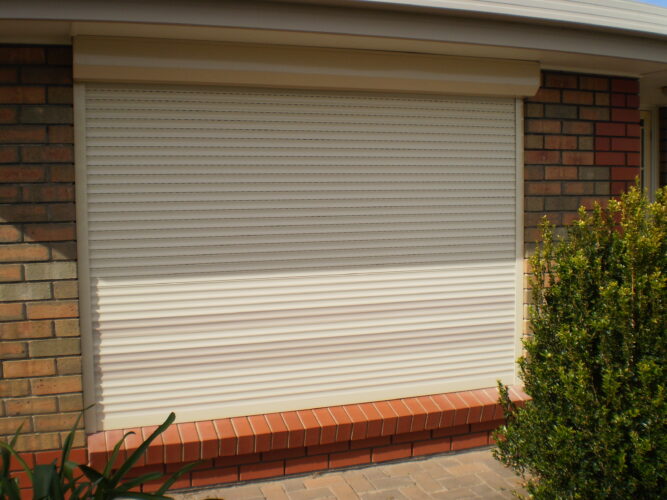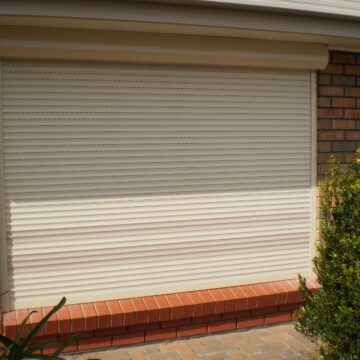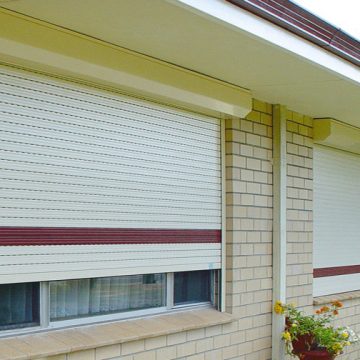For most Adelaide homeowners, a well-specified security roller shutter pays for itself through lower energy bills, fewer break-ins, and decades of trouble-free service—provided you choose the right product and installer. Prices can start near $300 for a small manual window and pass $1,800 for a wide motorised door, so the real question is whether the benefits outweigh that up-front outlay.
This guide unpacks every cost driver, lays out real-world price ranges, and weighs security, insulation, noise and resale gains against maintenance and aesthetic trade-offs. We’ll begin with a quick look at what a residential security roller shutter actually is—aluminium slats that roll into a slim headbox, operated by strap, switch or solar motor—and why they’ve become a common sight on South Australian homes and cafés alike over the past decade.
What Drives The Price Of A Security Roller Shutter?
Ask three suppliers for a quote and you’ll almost certainly receive three different numbers. That’s because the sticker price of residential security roller shutters is a cocktail of size, materials, mechanics, labour and the bells-and-whistles you tack on at the end. Understanding these levers lets you trim fat where it won’t be missed and spend where it really counts.
Size and Opening Type
Square metreage is the single biggest cost driver. A small bathroom window (about 0.6 m × 0.9 m) barely nudges the $300 mark for a basic strap-winder, while a 2.4-metre wide patio door can push past $1,800 once you factor in a beefier headbox and motor. Wide spans need stronger axle tubes and sometimes twin-shutter coupling, adding both material and labour hours. Doors and stacking sliders also sit lower to the ground, so most owners opt for upgraded bottom-bar locks—another modest line item on the invoice.
Material and Slat Construction
Not all aluminium is created equal. The everyday choice is a foam-filled roll-formed slat: light, insulated and affordable. Step up to a fully extruded profile and you gain serious smash-resistance along with BAL-40 or even BAL-FZ bushfire compliance—but expect to pay roughly 20–40 % more per square meter. If you live in a cyclone or ember-prone zone the premium is hard to dodge; in low-risk suburbs, foam-filled often hits the sweet spot between cost and security.
Operation Method
Manual straps or winders keep up-front costs low and run forever with little to break. Add a wired tubular motor and you’re typically tacking on $200–$400 per opening, plus an electrician’s call-out. Solar and battery kits avoid wall chasing but cost another $150–$250 and require periodic battery swaps. Smart-home integration—think Alexa, Google Home or C-Bus—needs a gateway module that can add $100–$300 per shutter. Convenience lovers swear by one-touch control; budget hawks often reserve motors for hard-to-reach upstairs windows only.
Installation Complexity
Mounting into double-brick at ground level is straightforward. Switch to fragile weatherboard, second-Storey heights, or heritage stone and the labour bill climbs. Scaffolding hire, lintel adjustments and licensed electrical work are common extras. While a handyman install might look cheaper on paper, a poor alignment can jam slats and burn out motors, wiping out any notional saving.
Extras, Finishes and Warranty
Colour beyond the stock palette, cyclone-rated bottom locks, remote controls, wind or sun sensors, keyed overrides—the accessory list is long and tempting. Each add-on is usually modest, yet they stack quickly. Finally, check the warranty line: entry-level packages may stop at five years, whereas premium ranges stretch to seven or ten. Longer coverage isn’t free; the cost is baked into the ticket price but often pays for itself if a motor fails in year eight.
By weighing these factors against your own priorities—security risk, energy bills, convenience and curb appeal—you’ll arrive at a figure that makes sense for your home and budget.
Typical Price Ranges Across Australia
Steel prices, exchange rates and even local labour awards have all shifted since COVID, so any price guide needs a 2025 disclaimer: use these figures as ballpark, not gospel. Still, most reputable suppliers from Perth to Hobart sit within the same broad brackets. The numbers below include GST and standard installation, giving you a realistic starting point when you ring around for quotes on residential security roller shutters.
One-Off vs Whole-House Packages
Ordering a single shutter for a vulnerable laundry window attracts full retail rates plus a call-out. Bundle five to ten openings and most installers shave 5–15 % off, because travel, set-up and electrical work are consolidated. End-of-financial-year sales and “buy now, pay later” plans can soften cash flow—handy if you’re juggling other renovation bills. Just read the fine print; zero-interest finance often includes an application fee or shorter warranty tier.
Ongoing and Hidden Costs
While day-to-day running costs are tiny (a tubular motor on standby draws about 1–2 W, or $4–$8 per year), there are a few pocket-hits to budget for:
- Service call for a jammed strap or motor reset: $130–$180.
- Replacement battery in a solar kit: every 5–7 years, roughly $145.
- Optional annual clean by a pro: $60–$130a window, worthwhile in coastal or bush-fire zones.
Factor those numbers into your cost-of-ownership spreadsheet and the true lifetime expense of a shutter sits well below rivals like security screens that need mesh replacements or alarm systems with monthly monitoring fees.
How Much Security Do They Really Add?
The most-googled question after price is “Do roller shutters actually stop burglars?” In short, properly installed residential security roller shutters are among the toughest window barriers you can buy without turning your home into Fort Knox. They don’t make a property impenetrable, but they do force intruders to bring heavier tools, make more noise and spend more time—three things crooks hate.
Physical Barrier and Visual Deterrent
Behind the neat powder-coat sits a wall of interlocking aluminium slats. Foam-filled profiles resist a lever attack from a screwdriver or small pry bar; fully extruded slats up the ante, shrugging off bricks, hammers and even a short crowbar. Bottom-bar key locks and side guides stop the curtain being lifted, while internal override switches let you secure the shutter from inside at night. From the street, the sight of a closed shutter broadcasts “hard target”, sending opportunistic thieves towards softer, glass-only windows next door.
Comparison With Other Home Security Measures
- Alarm systems alert you after entry; shutters aim to prevent it altogether.
- CCTV provides evidence but rarely stops a smash-and-grab in progress.
- Security screens offer good resistance, yet the mesh can still be cut with the right tool.
Ideally, you layer measures: shutters protect the glass, an alarm detects forced entry elsewhere and cameras record whatever happens. In that stack, shutters become the first physical hurdle, buying precious minutes whether you’re asleep or away on holiday.
Real-World Outcomes and Insurance Considerations
Police stats rarely isolate shutters, but insurers recognize their value. Many Australian providers shave 5–10 % off premiums when windows are protected by AS5039-compliant shutters, especially on ground-floor openings. Claims assessors note fewer successful break-ins and lower storm-damage payouts, thanks to shutters guarding against flying debris. Add the potential savings to the energy reductions discussed earlier and the security dividend is more than just peace of mind—it’s measurable dollars back in your pocket.
Added Benefits Beyond Security
Security may be the headline, but the everyday perks of residential security roller shutters are what owners rave about once the dust has settled and the tradies have left.
Thermal Insulation and Energy Savings
Independent CSIRO testing shows a closed aluminium shutter can block up to 90 % of summer heat gain and trim winter heat loss by around 70 %. In Adelaide’s climate that can cut a typical household’s heating–cooling bill by $350–$500 a year, shortening the pay-back period while keeping rooms noticeably more comfortable.
Noise Reduction
Living on a main road or under the flight path? Dropping the curtain knocks out as much as 50 % of external noise. Clients report softer traffic hum, fewer barking-dog interruptions and deeper sleep—without resorting to double-glazing or heavy drapes.
Light Control and Privacy
Slats can be fully closed for cinema-grade blackout, cracked open a touch for soft daylight, or raised clear when you want the view. Shift workers, nursery rooms and home-cinema buffs love the flexibility, and the one-way vision when louvres are tilted keeps prying eyes out.
Storm, Hail and Bushfire Protection
Foam-filled profiles shrug off golf-ball hail; extruded BAL-40/BAL-FZ models provide a compliant ember shield in bushfire areas. During summer storms the shutter stops wind-driven debris from smashing glass, sparing you emergency board-up costs and insurance excess.
Improved Property Value and Street Appeal
A colour-matched headbox and slim side guides integrate cleanly with modern façades, adding a subtle security cue without the “bars on windows” vibe. Real-estate agents report that energy-efficient, secure homes fetch higher offers and rent faster—small proof that looks and livability still command a premium.
Potential Drawbacks and Ongoing Responsibilities
No product is perfect and residential security roller shutters are no exception. Understanding the downsides—most of which revolve around money, upkeep and day-to-day use—helps you decide whether the upsides justify the investment.
Purchase and Installation Cost Barrier
Even the cheapest manual unit costs several times more than a set of venetians, and a whole-house motorized package can rival the price of a small bathroom renovation. Because shutters are custom-built, there’s little room for DIY savings unless you’re handy with flashing, wiring and waterproof sealing—skills most owners sensibly outsource.
Maintenance, Cleaning and Repairs
Aluminium doesn’t rust, but salt spray, dust and spider webs clog the side tracks if you ignore them. A quick hose-down every quarter and a silicone-spray on the guides once a year usually does the trick. Skip it and the curtain can jam, leading to $120–$180 service calls. Motors last 10–15 years; budgeting ~$250 each for replacements avoids bill shock down the track.
Operational Convenience and Safety
Close the shutters and you also shut out daylight. Some families find themselves living in a perpetual twilight because it’s easier than raising and lowering multiple windows. Emergency egress is another factor: ensure at least one bedroom shutter has a manual override or battery backup so occupants can exit during a blackout.
Aesthetic Concerns
The neatest install still adds a headbox and side rails to your façade. While colour-matching softens the commercial look, heritage homeowners sometimes balk at the visual bulk. Planning a new build? Recessed boxes and rendered side channels hide most hardware but need to be specified before bricks are laid.
Cost-Versus-Value: Crunching The Numbers
Sticker shock is real, but it doesn’t exist in a vacuum. The smart way to judge residential security roller shutters is by spreading the expense over the years of service and tallying every dollar they save or earn back. When you run the sums, the picture often looks a lot friendlier than the invoice.
Payback Period Calculation
EXAMPLE: Start with a whole-house install: five motorized shutters at an installed cost of $7,500. Post-installation monitoring shows your reverse-cycle air-con running 18 % fewer hours per year—roughly $450 off the energy bill in Adelaide’s climate. The simple payback formula is:
Payback (years) = Total Cost ÷ Annual Saving
= 7500 ÷ 450
≈ 13.3 years
That’s well inside the expected life of the system, and it ignores any security-related excess you dodge by deterring a single break-in.
Resale and Rental Yield Impact
Real-estate agents in Adelaide report that homes with integrated roller shutters command 1–2 % higher sale prices and attract tenants faster, thanks to lower energy bills and perceived safety. On a $650,000 property, a 1 % bump nets $6,500—effectively reimbursing the system cost at resale while you’ve enjoyed the comfort and security in the meantime.
Assessing Installers: Questions To Ask
- Are you factory-direct or a reseller?
- Do you employ licensed electricians or subcontractors?
- What is the lead time from order to install?
- Is public liability insurance and a workmanship warranty included?
- How do you handle call-outs after year five?
Why Local Manufacturing Matters (Adelaide Example)
Buying shutters built in Adelaide means:
- Faster turnaround and colour matching
- Spare parts on hand for urgent repairs
- Dollars staying in the SA economy
Classic Roller Shutters’ factory-direct model also cuts freight margins, keeping the final invoice lower and support just a phone call away.
Common Questions Homeowners Ask
Every quotation visit ends with the same handful of queries. Below are quick, no-fluff answers you can bank on when weighing up residential security roller shutters for your place.
How Much Do Residential Security Roller Shutters Cost?
Installed prices run from roughly $700 for a small manual bathroom window to $2,000 for a motorized, patio door depending on size. Most three-bedroom homes land between $8,000 and $10,000 once electrics, colours and discounts are applied.
Are Roller Shutters Really Worth It For Security?
Yes—when correctly installed they form a rigid barrier that deters smash-and-grab attempts and can shave 5–10 % off many insurance premiums.
Manual, Electric or Solar—Which Is Best Value?
Manual is outdated and labour intensive, manual shutters are now the same price as most battery options. Wired motors add convenience for around $400 extra each.
What Is The Lifespan Of A Motorized Roller Shutter?
Expect the aluminium curtain and guides to last 20–25 years. Tubular motors average 10–15 years before a straightforward replacement keeps everything rolling.
The Bottom Line
Counting every dollar in and out, residential security roller shutters stack up. They cost more than curtains on day one, yet the mix of break-in deterrence, energy savings, quieter rooms and higher resale usually pays that premium back well before the slats wear out. Add the comfort of knowing your windows are shielded during a summer storm or a 40 °C heatwave and the investment starts to feel less like a splurge and more like sensible home insurance.
If you’re curious where your own numbers land, the next logical step is a no-obligation measure and quote. Book a visit with the local team at Classic Roller Shutters Adelaide and see exactly how the figures stack up for your place.




